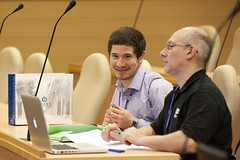… Well almost. After 2 airport transfers and 16 hours of flying, I made it to Taipei for the ISGC conference in Academia Sinica – incidentally this is also the furthest east I’ve travelled and the longest I’ve spent flying. With those boxes ticked, I was greeted by an overcast sky and a warm reception by the ISGC organising committee. The following day – and still jet-lagged – I attended the Asia@home Hackfest, which had some interesting volunteer projects on show. One of these was Shakemovie@home, by Professor Li Zhao, a seismology tool that takes advantage of volunteer computers idle processing time to simulate earthquake events. Using the remote processing from volunteer computers enables download and upload of data to be 3 times faster than using a local cluster of computers. Plus, the tool provides stimulating visualizations for volunteers.
The following day – and still jet-lagged – I attended the Asia@home Hackfest, which had some interesting volunteer projects on show. One of these was Shakemovie@home, by Professor Li Zhao, a seismology tool that takes advantage of volunteer computers idle processing time to simulate earthquake events. Using the remote processing from volunteer computers enables download and upload of data to be 3 times faster than using a local cluster of computers. Plus, the tool provides stimulating visualizations for volunteers.
Another presentation that was interesting was by David Anderson about the limits of volunteer computing. The current problem is there is a scientific consensus that volunteer computing is only useful for small processing tasks and individual scientists; examples include Seti@Home and Folding@Home. But, the benefits of volunteer computing are that they currently have 40 projects, 500,000 volunteers and process a total of 14 petaFLOPS globally. Even the largest conventional high-performance computer is only capable of reaching 1-2 petaFLOPS. To put this into perspective; this would cost $5 billion to run on the Amazon EC2 cloud service. With volunteer computing, this cost is divided by each volunteer as a small addition to their energy bills.
David is now thinking big and striving to change the perception of volunteer computing. He is trying to set up a network called Berkeley@Home at his base of operations, the University of California. Its aim is to support thousands of scientific applications by researchers on campus. So far, progress has been slow. He thinks there needs to be more promotion and outreach about his network to generate more interest and gain general acceptance by the research community.
On a less serious note, I managed to squeeze in a scenic walk on the grounds of Academia Sinica. Highlights include seeing the largest hornet or wasp ever and being captivated by the picturesque mountains and rhythmic bird song. If you ever stay at Academia Sinica I recommend it – here are some directions (Read the text under “Walk in the Sunshine”). Anyway back to the conference…




No comments:
Post a Comment